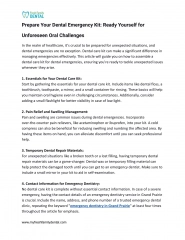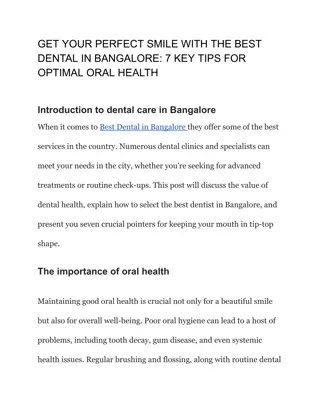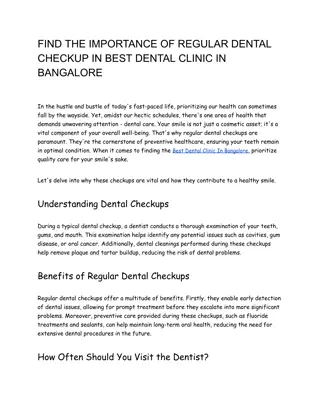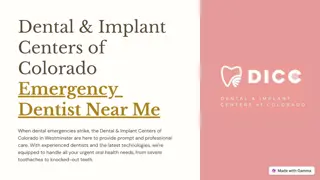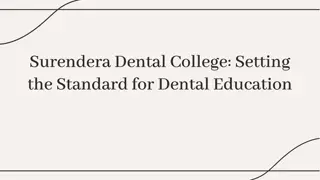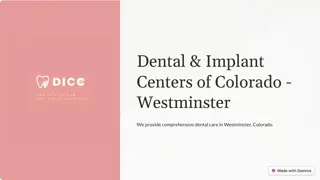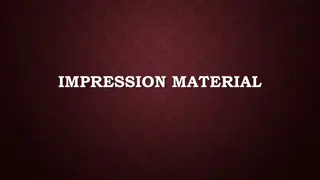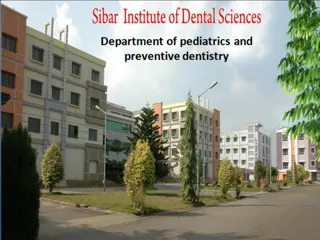
Understanding Mechanical Properties for Dental Restorations
Explore the mechanical properties crucial for evaluating the durability of dental restorations under masticatory forces. Learn about stress, strain, resistance, and types of forces that affect material deformations in the oral environment.
Download Presentation

Please find below an Image/Link to download the presentation.
The content on the website is provided AS IS for your information and personal use only. It may not be sold, licensed, or shared on other websites without obtaining consent from the author. If you encounter any issues during the download, it is possible that the publisher has removed the file from their server.
You are allowed to download the files provided on this website for personal or commercial use, subject to the condition that they are used lawfully. All files are the property of their respective owners.
The content on the website is provided AS IS for your information and personal use only. It may not be sold, licensed, or shared on other websites without obtaining consent from the author.
E N D
Presentation Transcript
INTRODUCTION 1. TYPES OF STRESS 2. STRAIN 3. STRESS STRAIN RELATIONSHIP 4. PROPORTIONAL LIMIT 5. ELASTIC LIMIT 6. YOUNG S MODULUS 7. RESILIENCE 8. FLEXIBILITY 9.
10. YIELD STRESS 11. TOUGHNESS DUCTILITY AND MALLEABILITY 1. FRACTURE TOUGHNESS 2. 14. ULTIMATE STRENGTH 15. COMPRESSIVE STRENGTH 16. TENSILE STRENGTH, DIAMETRAL TENSILE STRENGTH 17. SHEAR STRENGTH 18. FLEXURAL STRENGTH 19. FATIGUE STRENGTH
In the oral environment, restorations are subjected to heavy masticatiory forces. These forces act on teeth and/ or material producing different reactions that lead to deformation, which can ultimately compromise their durability over time. It is important to introduce some concepts that are extremely relevant to understand the performance presented by such materials under specific test conditions.
Mechanical properties are subset of physical properties that are based on the laws of mechanics that is the physical science that deals with energy and forces and their effects on the bodies. These properties are expressed most often in units of stress and strain.
When an external force is applied to acts a body, an internal force, equal in magnitude and opposite in direction to the applied force is set up in the body. This internal resistance to the external force is called STRESS Denoted by S or Designated as force per unit area ( =N/m ) Commonly stress is reported in terms of mega Pascals. Where, Pascal = 1 N / m .
Depending on the type of force applied, following stresses are produced Axial (Tensile and Compressive ) A. Shear (sliding) B. Flexural C.
When a body is subjected to compressive forces (two axial sets of force are applied to a sample directed towards each other in a straight line, in order to approximate the molecular structure of the material, an internal resistance developed in the body to oppose this force is called compressive stress. Compressive force Compressive stress
DEFINITION OF COMPRESSIVE STRESS: Ratio of compressive force to cross-sectional area perpendicular to the axis of applied force OR It is the force per unit area produced in the body in response to an externally applied force, which tends to compress (shorten) the material. It is accompanied by compressive strain.
Since most of masticatory forces are compressive in nature, it is important to investigate materials under this condition. Tooth Average masticatory force (N) Second molar 800 First molar 390 Bicuspids 288 Cupids 208 Incisors 155
When a body is subjected to tensile force (two sets of forces directed away from each other in a straight line) which tries to stretch or elongate the body, a resistance is developed in the body which is equal in magnitude and opposite in direction to the applied force. This internal resistance of the body to tensile force is called tensile stress. Tensile force Tensile stress
DEFINITION OF TENSILE STRESS It is the force per unit area produced in the body in response to an externally applied force, which tends to stretch(elongate ) the material. It is accompanied by tensile strain.
Shear is a result of two sets of forces directed parallel to each other , but not along the same straight line. Shear stress is the force per unit area produced in the body in response to an externally applied force, which tends to slide one portion of a body over another.
Tensile and compressive stresses along with shear, are the three simple examples of stress which form the basis of all other more complex stress patterns. FLEXURAL STRESS: Also called as bending stress. Produced by bending forces over the dental appliance.
The application of an external force to a body results in a change in dimension of that body. The magnitude of which depends on the applied force and the properties of the material. The numerical value of strain is given by the expression Strain = Change in length/Original length.= L/L Strain is dimensionless quantity because a unit length is divided by unit length.
The stain may be recoverable, that is the material will return to its original length after removal of the applied force (elastic strain), or the material may remain deformed, in which case the strain is non- recoverable(plastic strain). A third possibility is that the strain may be partially recoverable(visco elasticity).
Each type of stress is capable of producing a corresponding deformation in the body. Therefore, stress and strain are not independent and unrelated properties, but they are closely related and may be seen as cause and effect. The relationship of stress and strain is often used to characterize the mechanical properties of materials.
Stress- strain data are generally obtained using a mechanical Stress-Strain relationship testing machine, which enables strain to be measured as a function of stress and recorded automatically in the form of a graph called stress strain curve. Parts of universal testing machine
Click on it to watch a video related to tensile test and stress strain graph
Stress strain curve for a hypothetical material subjected to increased tensile stress until failure is shown in the figure.
As the stress is increased, the strain is increased. In the initial portion of the curve, from O to A, the strain is linearly proportional to the stress. When a stress that is higher than the value registered at A is achieved, the strain changes are no longer linearly proportional to the stress changes. Hence the value of the stress at A is known as the proportional limit. A y Proportional limit Stress Ultimate tensile strength Strain O
Proportional limit is defined as the greatest stress that a material will sustain without deviation from the linear proportionality of stress to strain
Defined as the maximum stress that a material can withstand without permanent deformation. Above elastic limit, a material undergoes irreversible plastic deformation and below the elastic limit, it shows reversible elastic deformation. NOTE Elastic deformation Bonds stretched No permanent damage Plastic deformation Bonds broken Permanent damage
Below elastic limit, no permanent deformation occurs in a structure. When the stress is removed, the structure will return to its original dimensions and the material is considered to be showing elastic nature. The region of stress-strain curve before the elastic limit is called the elastic region. E L Stress Strain
The application of stress greater than elastic limit results in permanent or irreversible strain in the specimen and the region of the stress strain curve beyond the elastic limit is called the plastic region. EL Stress Elastic Deformation Plastic Deformation Strain
For linearly elastic materials which obey Hookes law(stress directly proportional to strain) the elastic limit and proportional limit represent the same stress within the structure and the terms are often used interchangeably in referring to the stress involved.
Super elastic materials are exception to this. These materials exhibit nonlinear elastic behavior, and their relationship between stress and strain in the elastic region does not follow a straight line, but removal of the load results in a return to zero strain.
Super elastic material E P P- Proportional limit E- Elastic limit A-Yield strength
NOTE : Fundamental difference in the concept of proportional and elastic limit is one deals with proportionality of strain to stress in the structure, whereas the other describes elastic behavior of the material.
There are several important mechanical properties measuring reversible deformation and include 1) Elastic modulus ( young s modulus or modulus of elasticity or Hooke s law ) 2)Dynamic young s modulus 3) Flexibility 4) Resilience 5)Poisson s ratio
When a material deforms elastically, strain for a given stress is always the same and the two are related by Hooke s Law (stress is directly proportional to strain): where, =E is stress [ MPa ] E= E modulus of elasticity /constant of proportionality [MPa] strain [unitless or %]
From the Hookes law the modulus of elasticity is defined as the ratio of the stress to the strain in the linear or elastic portion of stress strain curve. E is measured by the slope of stress strain graph. It desribes relative stiffnes or rigidity of a material.
Therefore, it follows that lesser the strain for a given stress, greater will be the stiffness and higher the Young s modulus (E) and viceversa. Stress Stress Greater E Stiffness Lesser E flexiblility Strain Strain
Elastic modulus of a material is a constant and is unaffected by the amount of stress induced in a material. Thus it is not a measure of strength. Material with a high elastic modulus can have either high or low strength values. Stress Stress Stiff and Strong Stiff and Weak Strain Strain
APPLICATIONS The metal frame of a metal-ceramic bridge should have a high stiffness. If the metal flexes, the porcelain veneer on it might crack or separate. Such a material would possess a comparative high modulus of elasticity. A polyether material have greater stiffness than all other elastomeric impression materials. Thus a greater force is needed to remove a impression tray from undercuts in mouth.
NOTE: The modulus of elasticity is an inherent property of the material and cannot be altered appreciably by heat treatment, work hardening, or any other kind of conditioning. This property is called structure insensitivity.
ELASTICMODULUSOFMATERIALS Materials Elastic modulus (GPa) Enamel 84 Dentin 17 Gold (type IV)alloy 90-95 Amalgam 28-59 Co-Cr partial denture alloy 218-224 PMMA 2.4 Silicone elastomer for 0.002-0.003 maxillofacial prosthesis Feldspathic porcelain 69-70 Craig 12th edition
Can be measured by dynamic method. Ultrasonic longitudinal and transverse wave transducers and appropriate receivers are used. The velocity of sound wave and density of material are used to calculate elastic modulus.
It indicates the amount of energy necessary to deform a material to proportional limit. OR it is amount of energy absorbed by a structure, when it is stressed to proportional limit. Resilience is measured by the area under the elastic portion of stress strain curve. Resilience
Resilience has particular importance in the evaluation of orthodontic wires . It determines the magnitude of the force that can be applied to the tooth and how far the tooth can move before the spring is no longer effective.
Elastomeric soft liners absorb considerable amounts of energy without being permanently distorted when stressed and the energy stored is released when the material springs back to its original shape after removal of the applied stress. Therefore, these materials act as cushion between the hard denture base and soft tissues to reduce masticatory forces transmitted by prosthesis to the underlying tissues.
If large proximal strains are developed during compressive loading, a proximal inlay might absorb the energy and cause excessive movement of the adjacent tooth when the absorbed energy is released. Hence the restorative material should exhibit a moderately high elastic modulus and relatively low resilience.
It is the maximum elastic (recoverable) strain that occurs when a material is stressed to proportional limit. Therefore, it follows that greater the strain for a given stress in a material, greater will be it s flexibility. Proportional limit Flexibility
APPLICATIONS: Restorative materials should withstand high stresses and show minimum distortion or should have minimum flexibility. Impression materials should have large flexibility or elastic deformation to withdraw through severe undercuts without permanent deformation. Maxillofacial materials and soft denture reliners should have high flexibility.
There are several important mechanical properties measuring irreversible deformation and include 1) Yield strength 2) Toughness 3) Ductility and malleability 4) Fracture toughness 5) Ultimate tensile strength 6) Fracture strength
When a tensile force is applied along one axis to produce elongation, compressive strain is produced at right angles, proportionately. Within elastic range the ratio of lateral to the axial strain is called Poisson's ratio. Dental materials have Poisson's ratio value in range of 0.3 to 0.5.
Irregularities along the straight line region of the stress versus-strain plot may represent minor deviations from Hooke s law and cause some uncertainty in determining the precise point at which the selected line deviates from linearity(proportional limit). Thus a different property, yield strength, is used in cases where the proportional limit cannot be determined with sufficient accuracy.
Yield strength is the stress required to produce a small- specified amount of plastic deformation. To determine the YS for a material at 0.2% offset, a line is drawn parallel to the straight line region, starting at a value of 0.002, or 0.2% of the plastic strain, along the strain axis and is extended until it intersects the stress-strain curve. The stress corresponding to this point is the yield strength. Yield Strength Stress Strain 0.002 0.004
Yield strength indicates a functional failure of a material. Although the term strength implies that the material has fractured, it is actually intact but has sustained a specific amount of plastic strain (deformation) A restoration exhibiting a permanent deformation will be no more serving the purpose in spite of the fact that it didn t fracture. Yield stress is more important than the ultimate stress, because yield stress represents the clinical failure.
Yield strength determines whether the material is strong or weak. Yield Strength Yield Strength Strong Brittle Stress Strong Ductile Stress Strain Strain Yield Strength Yield Strength Stress Stress Weak Brittle Weak Ductile Strain Strain


